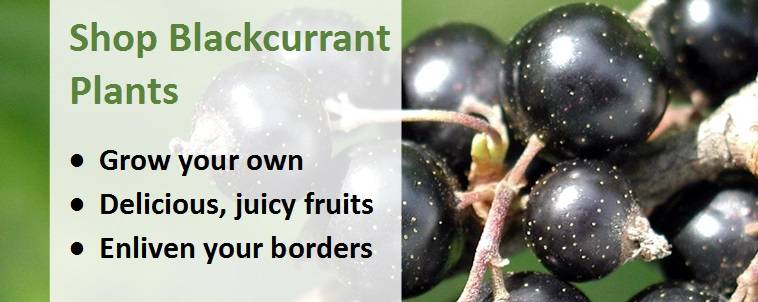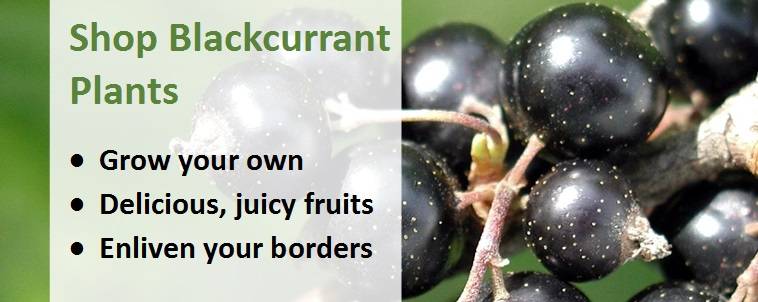How to Grow Your Own Blackcurrants
Blackcurrants are delightful, generous cropping fruit bushes that have been grown in the British Isles for over 500 years. Native to the temperate parts of central and northern Europe and northern Asia, they have aromatic leaves and produce flowers in racemes up to 8cm long and containing 10-20 flowers each in June. The flowers change colour from pink/green to red as the clusters fully emerge. They are then followed by bunches of small, glossy dark purple-black fruits that develop along the stems in mid-summer and can be harvested by hand. Blackcurrant plants are easy to grow and more tolerant of heavy soils than any other currant. They are also highly versatile - succeeding as part of a fruit collection in the border, an ornamental hedge or container-grown on the patio to save space in smaller gardens. Once planted, blackcurrants remain productive for almost 20 years.
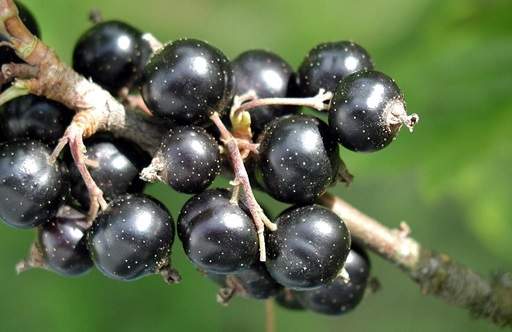
Small, glossy, dark purple-black fruits develop along the stems
Recommended Blackcurrant Varieties
The best blackcurrant varieties are:
Blackcurrant Ben Lomond - strong growing deciduous variety producing large crops of vitamin-rich blackcurrants in August. The sweet tasting fruits are borne on the previous year's growth and keep very well if frozen. They develop into heavy clusters all along the stems, hanging down low towards the ground under their own weight.
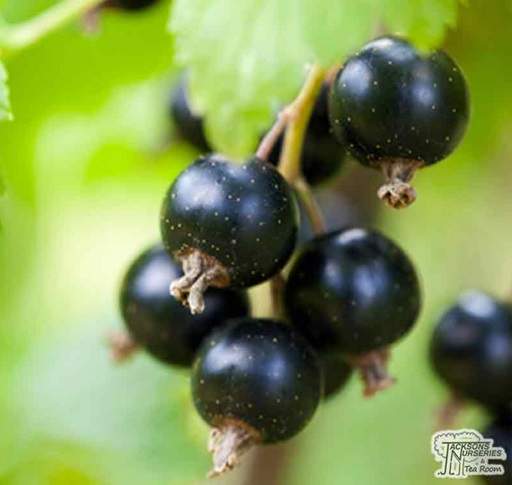
Blackcurrant Ben Connan - superb deciduous variety which produces mouth-watering fruit in abundance between July and August. These are very large and often cause the branches to bend under the weight of the fruits. It is noted for being easy to harvest and was specifically selected for small-scale growers where high yield per unit area, combined with ease of management, are important.
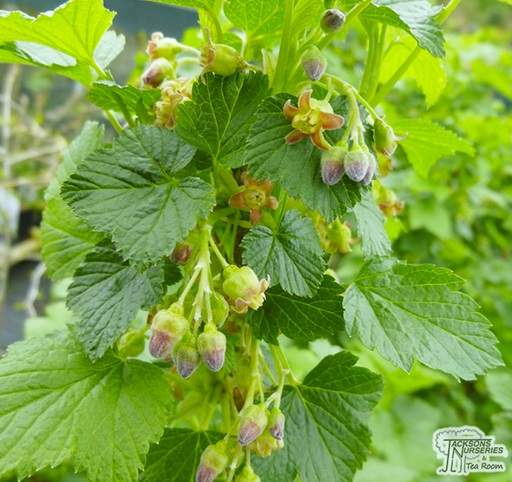
Fruits
Fruits are produced along 2 and 3 year old stems during early summer, initially appearing green before darkening to a deep, glossy purple-black in mid-summer as they form an edible berry 1cm in diameter. As fruits ripen, their weight often makes the stems droop low, close to the floor. If this happens, use a forked stick to hold them up to prevent them from touching the ground, where they are likely to rot or be eaten by wildlife. Birds often like to feed on blackcurrants, so protect your plants with netting and hang thin strips of foil from the stems to deter them during the fruiting season. Blackcurrants are ready for picking in mid to late summer (July and August), ideally around 7 days after they have turned blue-black. Cut whole bunches off together using scissors when the fruit is ripe, but still firm.
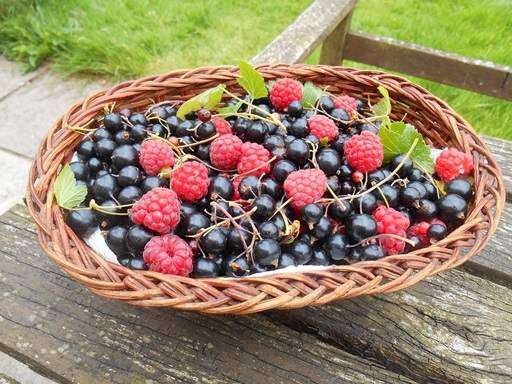
Protect your blackcurrant plants with netting during the fruiting season to get a good crop
Blackcurrants can be eaten raw but their tart flavour means they are most commonly cooked in a variety of sweet or savoury dishes. Blackcurrants make excellent jams, jellies, yoghurts, pies, wines, ice creams, syrups, cordials, cassis and, of course, juices. In fact, more than 90% of the UK's commercial crop is used in Ribena. Blackcurrant jam in particular is easy to make using 300ml of water and 600 grams of sugar to every 500 grams of fruit. Considered a 'super fruit' there are numerous health benefits of blackcurrants. They contain more vitamin C than any other natural food source, as well as high concentrations of the beneficial nutrients Potassium, Magnesium, Iron, Calcium and Vitamins A and B . Blackcurrants also possess a high content of anthocyanin and phytochemicals, which in turn promote antioxidant activity.
Planting Advice
Containerised blackcurrants can be planted any time of year, whilst bare root specimens should be planted from November through to March. Whatever the month, planting should always be avoided if the ground is very dry, frozen or waterlogged due to heavy and persistent rain. Blackcurrants are one of the few soft fruit bushes to like damp soil, providing it does not 'puddle', preferring a sheltered sunny spot, although dappled shade is tolerated (any areas more shady will result in weak and leggy growth). Avoid situating blackcurrants in frost pockets, as late frost can damage the flowers and lead to a smaller harvest.
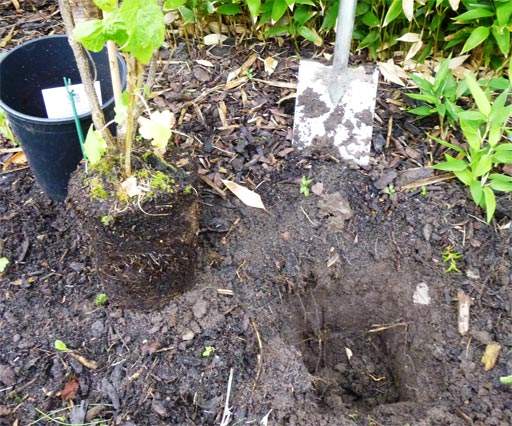
Containerised blackcurrants can be planted at any time of year providing the ground is not very dry, frozen or waterlogged
Dig a hole at least twice the diameter of the root ball and sprinkle a hand full of multi-purpose fertiliser into the hole, forking it into the soil. Set your blackcurrant plant 6cm (2.5") deeper than it was in the pot. Deep planting encourages vigorous young branches to develop annually from below ground; these are then used to replace older ones cut out after harvest. If you're planting a number of black, red or white currant varieties, leave 1.5m between plants and 1.8m between rows. Spread the roots of the blackcurrant bush out evenly across the hole area, carefully teasing out any pot-bound roots if necessary.
Incorporate lots of organic matter such as leaf mould, well-rotted garden compost or manure when back-filling, firm with your boot then water thoroughly. After planting, pull off any suckers growing from beneath ground level and prune each branch back to within 2 buds of ground level to leave a mass of stubby shoots. This should be done to buds that face outwards, rather than inwards, as that's where you'll want your fruit to appear and will encourage new growth from below ground level. By summer, the bush will have formed lots of new shoots that will carry fruit the following summer.
Blackcurrants can also be container grown very successfully. Blackcurrant Ben Connan is best for container growing in smaller gardens because it forms a neat and compact, frost-resistant bush of 90cm tall and delivers very high yields that are ready to pick in mid-July. Choose a container that is 45-50cm (10-20") in diameter and use a soil-based compost such as John Innes No 3 or multi-purpose compost mixed with one-third grit. The added benefit of growing blackcurrants in containers is that they can be moved into a shed or outbuilding if there is a late frost because, whilst blackcurrant bushes are winter hardy, cold weather at flowering time during the spring reduces the size of the crop.
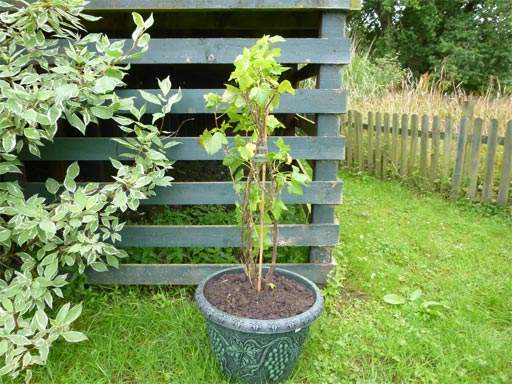
Blackcurrant Ben Connan is well suited to growing in containers
Blackcurrant Plant Care
Feed your blackcurrant plant with a balanced, slow release fertiliser in early spring, then top-up the mulch with a generous amount of leaf mould, well-rotted garden compost or manure every April to prevent unwanted weed growth. Additionally, we recommend applying a high-potassium liquid fertiliser (tomato feed is ideal) when the fruits start to swell in summer to boost production. Hand weed to keep the soil beneath your blackcurrants weed free and water regularly during periods of prolonged, dry weather, being careful not to overdo it as too much water during the fruiting time can cause the blackcurrants to split. In the harshest of winters, the roots of newly planted bushes can sometimes be lifted out of the ground by hard frosts. If this happens, firm them back in immediately to avoid lasting frost damage to the roots. If there is a late frost whilst your blackcurrants are starting to bloom, protect them by carefully covering your plants with horticultural fleece.
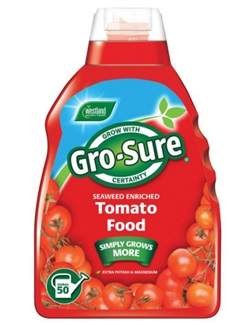
Apply a high-potassium liquid fertiliser like tomato feed when the fruits start to swell in summer
Pruning
Blackcurrant bushes need constant rejuvenation to ensure heavy crops. Fruit is produced predominantly on 2 and 3 year old stems, which then become quite unproductive; therefore, pruning should focus on the older stems, leaving the younger wood which will crop more abundantly. After the first growing season, remove spindly shoots and cut one strong shoot back to ground level in winter.
Thereafter, prune your blackcurrants more extensively between late autumn and late winter, firstly removing any dead, diseased or damaged stems, as well as those that are weak and spindly, crossing in the centre of the bush or leaning towards the ground. Next, remove a third of the oldest stems - those that are very dark or black - to the ground to leave plenty of room for healthy replacement stems to grow. Always undertake pruning work using a clean and sharp pair of secateurs.Time-poor gardeners may wish to combine pruning with the final fruit harvests.
Share this page:

